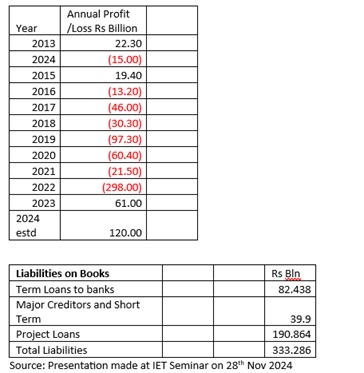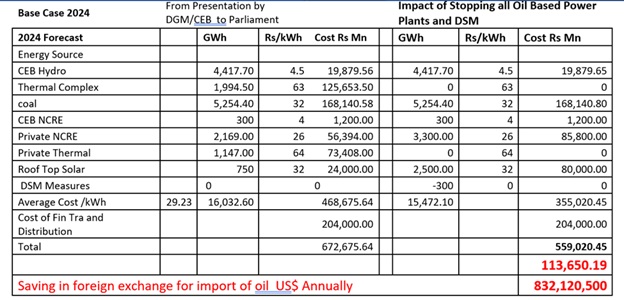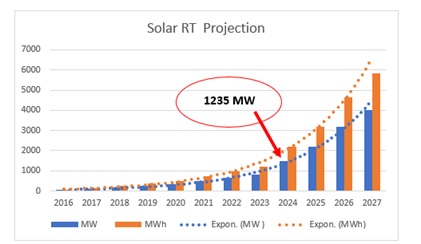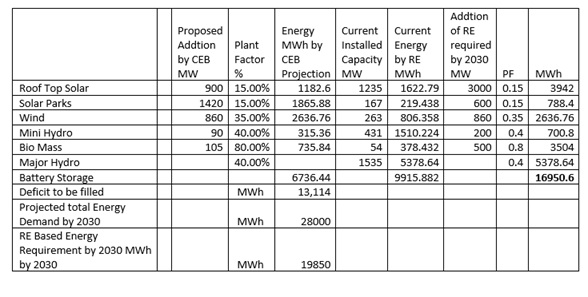Consumer Tariff can be reduced substantially by eliminating Oil based generation with Indigenous Renewable Energy
By Eng Parakrama Jayasinghe
The demand for reduction of the consumer electricity tariff is in much discussion. The first proposal made by the CEB has been rejected by the PUCSL as being inadequate and the revised offer is late in coming from the CEB . As such there will be no reduction forthcoming before end of 2024.
The consumer tariff is governed by the cost of generation of electricity to the CEB , which is now permitted to recover its costs. The CEB is not required to make profits. Any profits they do make should after making provisions for any development work be used to reduce the consumer tariff. They did make significant profits in the years 2023 and 2024 primarily due to the huge escalation of the consumer tariff in the recent past. However, it is also important to recognize the massive losses made in the past few years and the debt burden still carried in the books of the CEB as shown below.

It is imperative that these debts are brought down to a manageable level of the debacle faced by the RE developers in year 2022 , with payments delayed for over 14 months is to be avoided in the future. This is an essential guarantee necessary to maintain the confidence of the developers to invest on the many more RE projects needed , if the much desires goal of 70% contribution by RE by 2030 is to be achieved. Which is the mandate to the private sector developers entirely.
As such if the promised significant reduction of the consumer tariff is to feasible it is necessary to ensure reducing the average costs per unit of electricity. Fortunately the means of doing this in a few short years is clearly evident. The highest cost is from the oil based power generation only.
Therefore, the easiest and the best means of reducing the overall cost and thereby the consumer tariff is by eliminating the use of oil for power generation. This is now both technically and financially feasible. In addition there would be a saving of foreign exchange of nearly a Billion Dollars annually by the reduction of the import of oil.
Based on data presented by the CEB to the parliamentary oversight committee earlier this year the potential cost saving is shown below.

The current values of the cost of generation and the annual demand etc may have changed a little. But hat does not change the over all impact greatly. The above values have been quoted to avoid any claims of unsubstantiated data.
A very small amount of reduction of demand is also factored in by Demand Side Management . The projected reduction of 300 GWh per year can be achieved only by replacing 10,000,000 CFL bulbs with LED bulbs. The true potential is much greater providing low or Zero cost means of further reduction of cost of generation and thereby the Consumer Tariff. The saving of Rs 113,650,190,000 annually would enable the consumer tariff to be reduced by Rs 7.00 per Unit across the board. The added benefit is the greening of our power generation with added advantage for the competitiveness of our exports.
The targeted reduction is 3168 GWh per year of oil based generation , which is to be replaced by indigenous renewable energy sources which has no fuel cost, such as wind, solar and mini hydro. The biomass option is equally important being a source of firm power available 24/7 but the fuel is our own fuelwood supplied by the farers adding to their income rather than enriching the oil barons in the Middle East. While this can be targeted to be achieved over several years say 3 years maximum, the projects already in various stages of approval confirms the feasibility.
The present government has already declared its intention to add 2000 MW of solar energy within five years. However, based on the rapid progress made recently, particularly by the Roof Top Solar PV as depicted below, this time target appears not ot be challenging. We suggest that this be brought down to three years thus enabling the consumer tariff reduction can be achieved within that time frame.

The addition of RE to meet the 70% RE target by 2030 requires over all 3375 MW . The more relevant value is the addition of energy in MWh as the different ORE technologies have different plant factors. I have assessed this to be as follows using the projection of capacity addition published by the CEB recently .

It is clear that the CEB proposals will not meet the 70% RE target. The proposed additions required with a reasonable margin to cater for the variability and sensitivity to the weather patterns , particularly the contribution by the most important source The Major Hydro, a some what more ambitious additions have been proposed yielding 23687 MWh Vs the demand of 19850 MWh. Targeting this scale of achievement is warranted in that in addition to guaranteeing the 70% RE target , we will be on the way to the essential higher targets of great value to the Country in many ways.
Of course this cannot be achieved by lowering the Feed in Tariff for RE, as being attempted now and also by adding further impediments such as threats of “ Curtailing” the access which proposal is designed to make the SPPA totally un-bankable.
This will certainly not happen if there is no firm commitment by the CEB. As per past and even current experiences, it is futile to expect the CEB management to voluntarily accept this nationally crucial commitment. The change of attitude of the CEB to be the facilitator for this change, instead of the present role of a road block as experienced by all RE developers , in spite of their public pronouncements of supporting the development of RE, can only be expected by such official direction and assignment of responsibility and accountability .
Therefore, it is important that the CEB be given firm mandatory orders to achieve this change and submit time targeted plans to do so. The present Draft LTEGP upgraded suitably is the best device to implement this executive order.
We earnestly hope that His Excellency Hon Anura Kumara Dissanayake will recognize this inescapable ground reality and take immediate action.
 Eng. Parakrama Jayasinghe
Eng. Parakrama Jayasinghe
is a Chartered Mechanical Engineer with a BSc Eng (honours) degree from the University of Peradeniya. He is fellow of the Institution of Engineers Sri Lanka and a Member of the Institution of Mechanical Engineers London.




